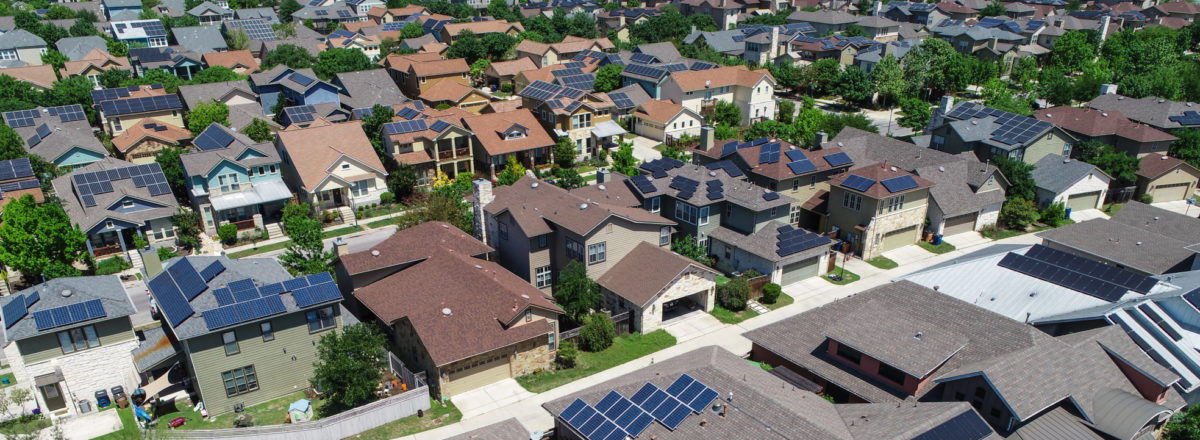For solar installers, a shortened project time can be the difference between a completed project and a cancellation. Delays can create a negative customer experience, and typically in the industry, a shorter project time equals a higher project pull-through rate.
EagleView, an aerial imagery company with origins in governmental contracts and insurance, recognizes this pressure on installers, and is now set to release a new product that promises to cut the solar project cycle by as much as two weeks. The company is releasing two products early Q2 this year that provides installers with the full suite of planning, design, and customer-facing sales. The products build upon capabilities demonstrated in EagleView’s Inform platform.
The “secret sauce” to the platform is the extremely high-resolution imagery that EagleView uses a fleet of 130 aircraft to capture. The company flies its craft above the project site, taking images from overhead and multiple low angles. Pieced together on the software platform, the images create a navigable 3D model of the building.
Peter Cleveland, EagleView’s VP of Solar, sat down with pv magazine at the recent NABCEP solar training conference in Phoenix to demonstrate the tool. This author’s residence was used as the demonstration site, and the level of detail was impressively sharp. Obstructions like piping and air conditioners on the roof were clearly modeled in 3D with pinpoint accuracy, and the shading analysis provided was quite detailed.
Cleveland held up a breath mint at the conference hall table, comparing it to a basketball. He said the difference in the two are representative of EagleView’s resolution compared to conventional initial design imagery. The aircraft capture six-inch resolution at fifteen-minute intervals. This is about four times more detailed than standard aerial imagery, and as much as 70 times more detailed than standard satellite imagery.
The result of this ultra-high resolution? Confidence.
Within moments, the tool was able to generate an optimal layout for the roof, taking in considerations like local roof setback policies and aesthetic preferences. Cleveland said that solar installers are often quite conservative with their initial customer designs, preferring to under-promise and over-deliver. While this is a reasonable customer service practice, it could lead to losing out on a bid versus another company that was more aggressive.
Now, with EagleView’s TrueDesign Sales platform, installers can confidently create a sales-ready design with accurate PVWatts-backed production forecasts. The shade analysis results were on-par with SunEye shade analysis.
The platform creates a sales-ready report for customers, empowering sales representatives to move projects forward. To use it, you don’t need solar design experience, said Cleveland.
The second product, TrueDesign, takes the platform beyond the point-of-sale, and creates an install-ready design. It has a one-button planning process and can fully generate a CAD design after a few hours of processing. “This is only possible through EagleView’s level of granularity,” said Cleveland.
This saves installers a lot of time and resources, as a truck roll is no longer necessary to bring a site surveyor to the home. It minimizes risks for installers who have employees climbing ladders for manual pen-and-paper site surveys on rooftops, as well. Interior structures must still be manually observed, but the shortened site survey time makes teams nimbler.
Cleveland said the user-friendly tool simplifies the installation process, and it is a readymade platform that could support roofing contractors looking to break into the PV space.
The two products are currently going through trials in an early evaluator program of 40 companies. Cleveland said the trials have been effective in cutting project times as promised. The company held a webinar April 7th to introduce the products.
“EagleView reports help us to eliminate in-person site surveys and shorten project lifecycles by up to two weeks. Everyone wins: homeowners go solar faster, our dealers avoid an additional site visit, and we reduce project overhead,” said Jake Wachman, VP of software at SunPower.
This content is protected by copyright and may not be reused. If you want to cooperate with us and would like to reuse some of our content, please contact: editors@pv-magazine.com.









By submitting this form you agree to pv magazine using your data for the purposes of publishing your comment.
Your personal data will only be disclosed or otherwise transmitted to third parties for the purposes of spam filtering or if this is necessary for technical maintenance of the website. Any other transfer to third parties will not take place unless this is justified on the basis of applicable data protection regulations or if pv magazine is legally obliged to do so.
You may revoke this consent at any time with effect for the future, in which case your personal data will be deleted immediately. Otherwise, your data will be deleted if pv magazine has processed your request or the purpose of data storage is fulfilled.
Further information on data privacy can be found in our Data Protection Policy.